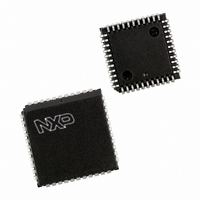P89C662HBA/00,512 NXP Semiconductors, P89C662HBA/00,512 Datasheet - Page 30

P89C662HBA/00,512
Manufacturer Part Number
P89C662HBA/00,512
Description
IC 80C51 MCU FLASH 32K 44-PLCC
Manufacturer
NXP Semiconductors
Series
89Cr
Datasheet
1.P89C660HBA00512.pdf
(89 pages)
Specifications of P89C662HBA/00,512
Core Processor
8051
Core Size
8-Bit
Speed
33MHz
Connectivity
I²C, UART/USART
Peripherals
POR, PWM, WDT
Number Of I /o
32
Program Memory Size
32KB (32K x 8)
Program Memory Type
FLASH
Ram Size
1K x 8
Voltage - Supply (vcc/vdd)
4.5 V ~ 5.5 V
Oscillator Type
Internal
Operating Temperature
0°C ~ 70°C
Package / Case
44-PLCC
Lead Free Status / RoHS Status
Lead free / RoHS Compliant
Eeprom Size
-
Data Converters
-
Other names
568-1269-5
935267444512
P89C662HBA
935267444512
P89C662HBA
Available stocks
Company
Part Number
Manufacturer
Quantity
Price
Company:
Part Number:
P89C662HBA/00,512
Manufacturer:
NXP Semiconductors
Quantity:
10 000
Philips Semiconductors
I
An I
uncontrolled source. If the SCL line is obstructed (pulled LOW) by a
device on the bus, no further serial transfer is possible, and the
SIO1 hardware cannot resolve this type of problem. When this
occurs, the problem must be resolved by the device that is pulling
the SCL bus line LOW.
If the SDA line is obstructed by another device on the bus (e.g., a
slave device out of bit synchronization), the problem can be solved
by transmitting additional clock pulses on the SCL line (see
Figure 14). The SIO1 hardware transmits additional clock pulses
when the STA flag is set, but no START condition can be generated
because the SDA line is pulled LOW while the I
free. The SIO1 hardware attempts to generate a START condition
after every two additional clock pulses on the SCL line. When the
SDA line is eventually released, a normal START condition is
transmitted, state 08H is entered, and the serial transfer continues.
If a forced bus access occurs or a repeated START condition is
transmitted while SDA is obstructed (pulled LOW), the SIO1
2002 Oct 28
2
C Bus Obstructed by a Low Level on SCL or SDA
80C51 8-bit Flash microcontroller family
16KB/32KB/64KB ISP/IAP Flash with 512B/1KB/2KB/8KB RAM
2
C bus hang-up occurs if SDA or SCL is pulled LOW by an
08H
S
STA FLAG
SDA LINE
SCL LINE
SLA
W
Figure 12. Simultaneous Repeated START Conditions from 2 Masters
18H
A
TIME OUT
2
Figure 13. Forced Access to a Busy I
C bus is considered
DATA
OTHER MASTER SENDS REPEATED
START CONDITION EARLIER
28H
A
30
S
hardware performs the same action as described above. In each
case, state 08H is entered after a successful START condition is
transmitted and normal serial transfer continues. Note that the CPU
is not involved in solving these bus hang-up problems.
Bus Error
A bus error occurs when a START or STOP condition is present at
an illegal position in the format frame. Examples of illegal positions
are during the serial transfer of an address byte, a data, or an
acknowledge bit.
The SIO1 hardware only reacts to a bus error when it is involved in
a serial transfer either as a master or an addressed slave. When a
bus error is detected, SIO1 immediately switches to the “not
addressed” Slave mode, releases the SDA and SCL lines, sets the
interrupt flag, and loads the status register with 00H. This status
code may be used to vector to a service routine which either
attempts the aborted serial transfer again or simply recovers from
the error condition as shown in Table 8.
START CONDITION
BOTH MASTERS CONTINUE
WITH SLA TRANSMISSION
P89C660/P89C662/P89C664/
2
C Bus
SU00975
SU00976
P89C668
Product data
















